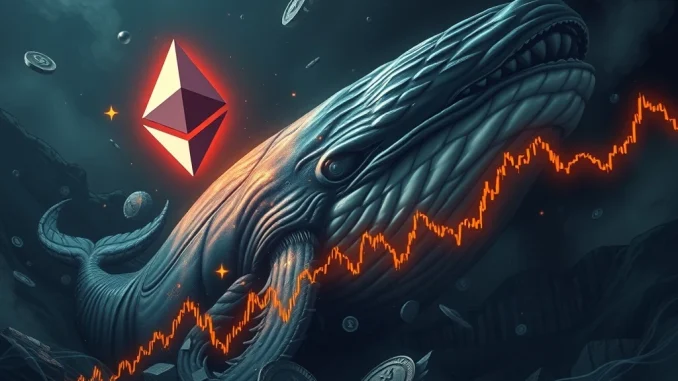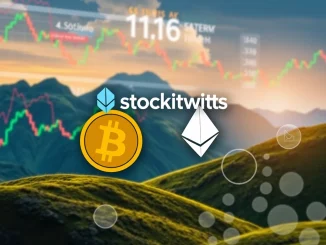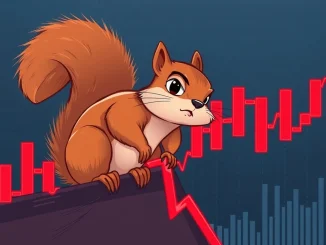
The world of cryptocurrency trading is often described as a high-stakes arena, where fortunes can be made or lost in the blink of an eye. Nothing exemplifies this more vividly than the recent plight of a prominent Ethereum whale. This colossal investor, identified by the address 0x2258, is currently teetering on the brink of a massive financial setback, facing a staggering $3.5 million loss on an Ethereum short position. It’s a gripping reminder of the volatile nature of digital assets and the razor-thin margins that define leveraged trading.
What Exactly Happened with This Ethereum Whale?
Imagine being so confident in a market downturn that you bet millions against one of the most popular cryptocurrencies. That’s precisely what an Ethereum whale did. This specific address, 0x2258, has taken a significant short position on Ethereum (ETH), employing an astonishing 18x leverage. For those unfamiliar, a short position is a bet that an asset’s price will fall. Traders ‘borrow’ an asset, sell it, and hope to buy it back later at a lower price to return it, pocketing the difference. Leverage, on the other hand, amplifies both potential gains and losses by allowing traders to control a large position with a relatively small amount of capital.
In this particular case, the whale’s conviction has backfired, at least for now. According to on-chain analytics firm Lookonchain, the address is currently staring down a $3.5 million unrealized loss. This isn’t just a minor dip; it’s a substantial sum that highlights the extreme risks associated with high-leverage trading in a notoriously unpredictable market.
The Perils of an ETH Short Position: What’s the Liquidation Price?
The core of this whale’s dilemma lies in the liquidation price. For any leveraged position, there’s a point at which the market moves so unfavorably that the trader’s collateral is no longer sufficient to cover the potential losses. At this point, the exchange automatically closes the position to prevent further losses, a process known as liquidation. For the 0x2258 address, this critical threshold for their ETH short is set at $3,321.81. If Ethereum’s price climbs above this level, the whale’s entire position will be automatically closed, and their $3.5 million loss will become very real and permanent.
This situation puts immense pressure on the whale and serves as a cautionary tale for anyone considering high-leverage trades. Betting against a volatile asset like Ethereum, especially with such significant leverage, requires not only deep market insight but also an iron stomach. The market’s recent movements have clearly gone against this whale’s initial prediction, pushing them closer to the edge of liquidation.
Understanding Crypto Liquidation and Its Domino Effect
Crypto liquidation is a fundamental, albeit often painful, mechanism in the world of leveraged trading. When a trader’s margin balance falls below a certain threshold, the exchange forces the closure of their position to prevent their losses from exceeding their initial collateral. This is a protective measure for both the exchange and the trader, ensuring that losses don’t spiral into negative equity.
While this particular whale’s potential liquidation is a personal financial event, large-scale liquidations can have broader market implications. A significant liquidation can trigger a cascade, especially if the forced selling puts downward pressure on the asset’s price, leading to further liquidations of other leveraged positions. This ‘domino effect’ can amplify market volatility and contribute to sharp price swings. It’s why analysts closely watch large leveraged positions, as their forced closure can sometimes act as a market catalyst, either up or down depending on the direction of the original bet.
The High Stakes of Leverage Trading: A Double-Edged Sword
Why do traders, especially whales, engage in leverage trading despite its inherent risks? The answer is simple: amplified returns. Leverage allows traders to multiply their potential profits from successful trades. With 18x leverage, a 1% move in ETH’s price could translate into an 18% gain on the initial capital. This allure of outsized returns is powerful, drawing in both seasoned professionals and ambitious newcomers.
However, as the Ethereum whale’s situation vividly demonstrates, leverage is a double-edged sword. While it magnifies gains, it equally magnifies losses. A small adverse price movement can quickly wipe out a trader’s entire collateral. This makes risk management paramount. Understanding your liquidation price, setting stop-loss orders, and never risking more than you can afford to lose are critical principles for anyone venturing into leveraged positions. The transparency of blockchain allows services like Lookonchain to track these large positions, offering a glimpse into the high-stakes games played by crypto’s biggest players.
What This Means for Ethereum Price Action Going Forward?
The precarious position of this Ethereum whale raises interesting questions about future Ethereum price action. If ETH continues its upward trajectory and breaches the $3,321.81 liquidation price, it could potentially trigger a ‘short squeeze.’ A short squeeze occurs when an asset’s price rises, forcing short sellers to buy back the asset to cover their positions. This sudden buying pressure can further propel the price upwards, creating a self-reinforcing rally.
Conversely, if Ethereum’s price were to reverse course and decline, it would alleviate the pressure on the whale’s short position, potentially allowing them to close it at a smaller loss or even turn a profit if ETH drops significantly. This whale’s predicament, therefore, becomes a focal point for market observers, as its resolution could influence short-term price movements and market sentiment surrounding Ethereum. Traders will be closely watching ETH’s performance around that critical liquidation level.
Actionable Insights for Traders: Navigating Volatile Waters
The story of the Ethereum whale offers several crucial lessons for every cryptocurrency trader, regardless of their experience level:
- Understand Leverage Thoroughly: Before using leverage, grasp its mechanics and the magnified risks. A small initial investment can lead to significant losses if not managed carefully.
- Risk Management is Key: Always define your maximum acceptable loss. Use stop-loss orders to automatically close positions if the market moves against you, protecting your capital.
- Don’t Chase Whales Blindly: While tracking large investors can be insightful, their strategies are often complex and not suitable for everyone. Their deep pockets also allow them to withstand losses that retail traders cannot.
- Market Volatility is Constant: Cryptocurrency markets are inherently volatile. Prices can change rapidly, making high-leverage positions extremely risky.
- Transparency is a Tool: On-chain data platforms provide unprecedented transparency into large trades. Use these tools to understand market dynamics, but always combine them with your own research and risk assessment.
A Compelling Summary: The High-Wire Act of Crypto Trading
The saga of the Ethereum whale facing a potential $3.5 million loss on an ETH short position serves as a potent reminder of the exhilarating yet perilous nature of cryptocurrency trading. It underscores how quickly fortunes can shift, especially when high leverage is involved. While the allure of massive gains is undeniable, this incident vividly illustrates the equally significant risk of devastating losses.
As the crypto market continues to evolve, stories like this highlight the importance of prudent risk management, a deep understanding of market mechanics, and a healthy respect for volatility. Whether the Ethereum whale manages to escape liquidation or succumbs to the market’s relentless pressure, their high-stakes gamble will undoubtedly be remembered as another dramatic chapter in the ongoing narrative of digital finance.



